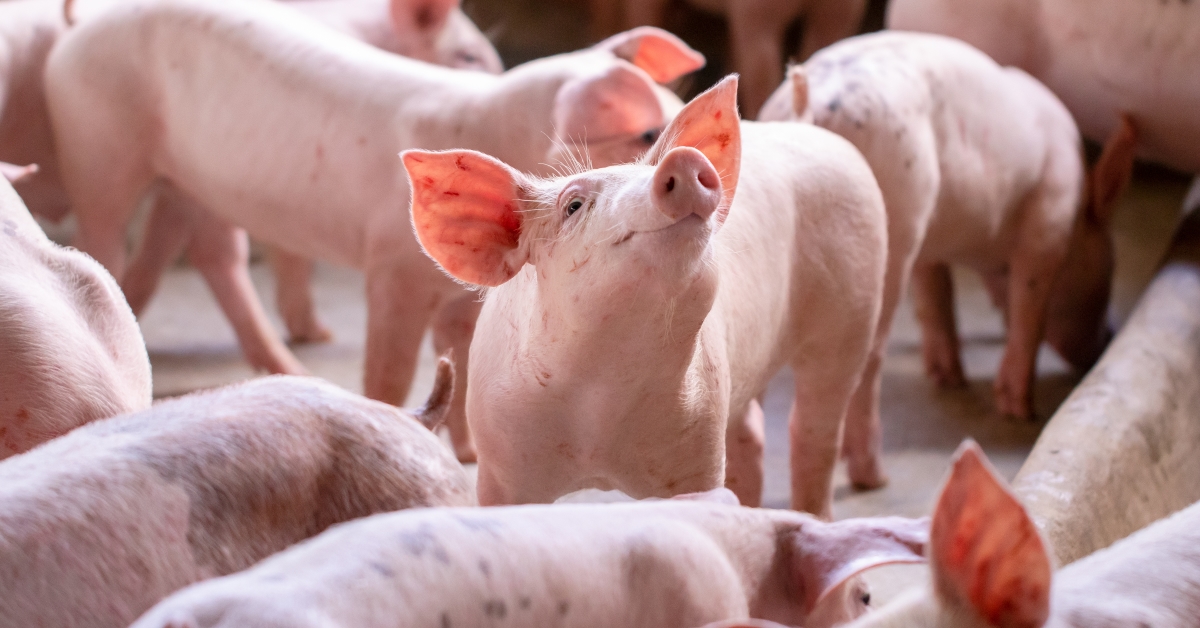
Traditionally, hog prices follow seasonal patterns, with annual highs in the summer and lows in the fall and winter. This phenomenon is driven by multiple factors, which include:
- higher pork demand in summer, for grilling and outdoor activities
- decreased breeding and farrowing performances observed during hot months, known as seasonal infertility syndrome
- lower voluntary feed intake in all pig categories during heat stress periods, resulting in slower growth
In summer, the presence of additional environmental stressors, including heat, can severely impact growth performance. Of course, we must ensure that animals are constantly supplied with fresh water during this time. But nutrition also plays a surprisingly pivotal role in preventing the problems associated with heat stress.
During the hotter months, grow-finish pigs in particular significantly decrease voluntary feed intake. Therefore, if the objective is to take advantage of summer markets, nutritionists must carefully re-balance the nutrient composition to meet specific requirements at different stages of growth, considering the changes in feed intake. This includes optimizing levels of energy, amino acids and minerals to support healthy growth, efficient feed utilization and overall well-being.
Nutritional strategies such as adjustments to dried distillers grains with solubles (DDGS), soybean meal, fat, and feed additives are all proven to help maximize growth and performance for pigs marketed in summer. By lowering DDGS and increasing corn, we can increase the net energy of the diet and ensure that pigs are getting adequate nutrition, even given a decrease in feed intake. As with DDGS, it’s advised to offset soybean meal with an increase in synthetic amino acids. Pigs fed high-crude-protein diets tend to have higher heat increment levels, and this is counterproductive, especially during the hotter months.
Additionally, incorporating fats or oils into pig diets can create a more energy-dense feed, reducing the overall amount of feed required to meet pigs’ requirements for optimal growth. A rule of thumb nutritionists use to determine whether fat prices into rations is whether fat is four times or less than the price of corn. Although a simplistic approach, it can give a quick idea around the economics of fat. More complex economic models have been developed and are available for in-depth analysis.
Fat can improve feed efficiency in grow-finish pigs any time of year, but it is typically most cost-effective when fed in the summer, when pigs tend to eat less. On average, feed efficiency is improved by 2% for each 1% increment of added fat. Although this is significantly more variable, improvements in average daily gain may also be increased by 1% for each 1% addition of fat.
In addition to adjusting macronutrients, we can use feed additives to enhance growth performance during summer-induced heat stress. For instance, the inclusion of tribasic copper chloride in grow-finish diets has consistently demonstrated positive outcomes, yielding higher hot-carcass weights, average daily gain and feed intake, all of which are pivotal in the summer. Some supplements available from Hubbard, like Assist™ and Opti-Pak® Efficiency, have been shown to enhance growth performance by optimizing pH levels in the digestive tract and augmenting nutrient utilization.
It takes pigs roughly 115 to 120 days to grow from 50 to 280 lb. Therefore, to capitalize on the profits of the summer markets, we must consider grow-finish diet modifications starting as early as February.
A variety of beneficial feed additives is available in the marketplace. Consult with your nutritionist to identify the most suitable feed additives for your specific needs.
Nutritional values of ingredients
Accurate nutrient values for ingredients are paramount in formulating swine diets that precisely meet the nutritional requirements of pigs. Each ingredient contributes differently to the overall nutrient profile, and variations in nutrient content can significantly impact pig performance and diet cost. If we overestimate or underestimate the value of an ingredient, we can miss that optimal market window and face discounts at the packing plant. Relying on precise nutrient values ensures that diets are formulated correctly, promoting optimal growth rate, feed efficiency and diet costs.
Routine sampling and testing of raw ingredients helps provide us with accurate nutrient values and allows nutritionists to adjust nutrient loadings as needed. For example, if a nutritionist is using soybean meal (SBM) with a crude protein level listed at 48% in the ingredient profile, but the actual crude protein content is 46%, the discrepancy could cost producers an extra ~$0.20 per pig in feed costs to feed a pig from 50 to 280 lb., due to the inaccuracies of the ingredient profile. This decrease in crude protein could also decrease growth performance and disrupt the ideal window for marketing.
If nutritionists have the correct nutrient loadings for each ingredient, they can predict pig performance (ADG and F/G) more accurately. This allows for ongoing nutritional adjustments that will support the pigs in reaching the desired market weight within the optimal timeframe. This not only maximizes profitability but also minimizes production costs associated with extended time in the barn.
With the help of feed formulation technology, the nutrient profiles of ingredients can be uploaded, along with growth prediction equations, in order to more precisely formulate least-cost rations to maximize economic and sustainability metrics. Instead of just using a standard ingredient for all pigs, we can formulate diets to maximize producer profitability as a result of targeted and predictable animal performance.
- Log in to post comments
